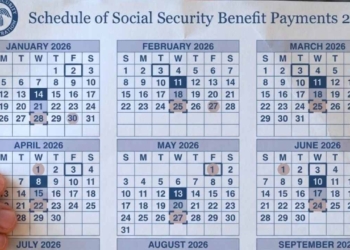As Congress becomes entangled in budget battles that threaten to paralyze the federal government, millions of Social Security Disability Insurance (SSDI) beneficiaries face not only the uncertainty of their monthly checks, but also a potentially devastating blow to their 2026 cost-of-living adjustment (COLA) payments.
In a month marked by the outstanding October 15 and 22 deposits—a vital funding source for 8.9 million Americans with SSDI disability benefits—the government shutdown that began last weekend could delay the COLA announcement, leaving vulnerable families in a financial limbo that exacerbates inflationary erosion.
Why does this government shutdown, the third in a decade, threaten to rob a modest but crucial increase that could inject up to $44 extra into the average benefit? The answer is as simple as it could bring complex consequences for Americans.
Is the SSDI schedule at risk to be delayed?
SSDI, a work-based benefit for disabled workers, operates under a strict schedule that offers a partial reprieve in October 2025. The first payment of the month arrived on October 8 for those born between the 1st and 10th, but the two outstanding payments—the 15th for those whose birthdays were between the 11th and 20th, and the 22nd for those between the 21st and 31st— will arrive on time, despite the government shutdown.
These deposits, processed by the Social Security Administration (SSA), follow the beneficiary’s birthday, an efficient mechanism that spreads the burden but, in times of crisis, exposes flaws. For the 40% of recipients waiting for the 22nd, a minor delay due to computer glitches is already a possibility, but the real drama unfolds on the horizon: the 2026 COLA, whose announcement was scheduled for today, October 15.
The valid amounts SSDI in October 2025
In 2025, after a 2.5% COLA, the maximum SSDI payment reaches $4,018 per month, an amount reserved for taxpayers with exceptional work histories. However, precariousness is the norm: the average benefit is $1,576, barely covering 70% of the basic needs for a single-person household, according to the SSA.
This figure changes with retirement age (if the beneficiary reaches this age, the SSDI becomes a permanent pension): at 66 years and four months—full retirement age for the class of 1959—the average for transitions from SSDI to retirement rises to $1,976, reflecting adjustments for longevity.
For early retirees at 62, it falls to $1,500, penalizing those whose disability robs them of years of contributions. By comparison, retirees without a disability history average $2,008, a gap that underscores the inequity: the system rewards prolonged survival, not resilience in the face of adversity.
The SSDI and the COLA announcement delay: What to expect
Here comes the shutdown: with thousands of federal employees on furlough, including Department of Labor analysts calculating the CPI, the COLA determination process is bogged down. Experts like Mary Johnson, a Medicare and Social Security analyst, warn that the announcement could be postponed until late October or November, delaying implementation until January 2026.
This not only delays relief—crucial to covering rent or healthcare increases—, yet it also sows distrust in a system already overwhelmed by appeals, with a 15% increase in inquiries according to the National Disability Rights Network. “It’s administrative cruelty,” tweets Senator Elizabeth Warren, pointing to Republican intransigence. Mitch McConnell, for his part, defends cuts as “essential for sustainability,” ignoring the fact that SSDI is funded by past contributions, not annual budgets.







